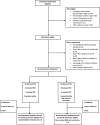Randomised controlled trial to investigate the effectiveness of thoracic epidural and paravertebral blockade in reducing chronic post-thoracotomy pain (TOPIC): a pilot study to assess feasibility of a large multicentre trial
- PMID: 31292172
- PMCID: PMC6624049
- DOI: 10.1136/bmjopen-2018-023679
Randomised controlled trial to investigate the effectiveness of thoracic epidural and paravertebral blockade in reducing chronic post-thoracotomy pain (TOPIC): a pilot study to assess feasibility of a large multicentre trial
Erratum in
-
Correction: Randomised controlled trial to investigate the effectiveness of thoracic epidural and paravertebral blockade in reducing chronic post-thoracotomy pain (TOPIC): a pilot study to assess feasibility of a large multicentre trial.BMJ Open. 2019 Aug 15;9(8):e023679corr1. doi: 10.1136/bmjopen-2018-023679corr1. BMJ Open. 2019. PMID: 31420402 Free PMC article. No abstract available.
Abstract
Objectives: Thoracotomy is considered one of the most painful surgical procedures. The incidence of chronic post-thoracotomy pain (CPTP) is up to 50%. Paravertebral blockade (PVB) may be superior to thoracic epidural blockade (TEB) in preventing CPTP. The specific objective of this pilot study was to assess the feasibility of conducting a larger trial to determine whether PVB at thoracotomy is more effective in reducing CPTP compared with TEB.
Design: A randomised, parallel, external pilot study was conducted to assess whether a large randomised trial of TEB and PVB with CPTP as the primary outcome is feasible.
Setting: Two adult thoracic centres in the UK.
Participants: All adult patients admitted for elective open thoracotomy. Participants were excluded if they were American Society of Anesthesiologists physical status IV or V; or if there is contraindication to local anaesthetics; infection near the proposed puncture site; coagulation/thoracic spine disorders; required chest wall resection or emergency thoracic surgery or had a previous thoracotomy.
Results: All patients presenting for thoracotomy were screened over a 12-month period with 194 found to be eligible. Of these, 69 (36%) were randomised (95% CI 29% to 42%). Discounting five participants who died, 54 of 64 participants (84%) returned questionnaire booklets at 6 months. The number of participants indicating at least a moderate level of chest pain at 6 months was lower with PVB but with high levels of uncertainty (RR: 0.7; 95% CI 0.3 to 1.7 for worst pain; RR: 0.3; 95% CI 0.0 to 2.8 for average pain). There were no safety concerns.
Conclusions: A large, multicentre randomised controlled trial of PVB versus TEB is feasible as it is possible to randomise and follow up participants with high fidelity. Pain scores were lower on average with PVB compared with TEB but a much larger trial is required to confirm this reliably.
Trial registration number: ISRCTN45041624.
Keywords: adult anaesthesia; clinical trials; pain management; thoracic surgery.
© Author(s) (or their employer(s)) 2019. Re-use permitted under CC BY. Published by BMJ.
Conflict of interest statement
Competing interests: None declared.
Figures
Similar articles
-
Study protocol for a randomised controlled trial to investigate the effectiveness of thoracic epidural and paravertebral blockade in reducing chronic post-thoracotomy pain: 2 (TOPIC 2).Trials. 2023 Nov 23;24(1):748. doi: 10.1186/s13063-023-07463-1. Trials. 2023. PMID: 37996898 Free PMC article.
-
Randomised controlled pilot study to investigate the effectiveness of thoracic epidural and paravertebral blockade in reducing chronic post-thoracotomy pain: TOPIC feasibility study protocol.BMJ Open. 2016 Dec 1;6(12):e012735. doi: 10.1136/bmjopen-2016-012735. BMJ Open. 2016. PMID: 27909035 Free PMC article. Clinical Trial.
-
Persistent Postsurgical Pain Following Thoracotomy: A Comparison of Thoracic Epidural and Paravertebral Blockade as Preventive Analgesia.Pain Med. 2019 Sep 1;20(9):1796-1802. doi: 10.1093/pm/pny293. Pain Med. 2019. PMID: 30789665
-
Paravertebral Block for Thoracic Surgery.J Cardiothorac Vasc Anesth. 2018 Apr;32(2):915-927. doi: 10.1053/j.jvca.2017.10.003. Epub 2017 Oct 4. J Cardiothorac Vasc Anesth. 2018. PMID: 29169795 Review.
-
Assessment of Intercostal Nerve Block Analgesia for Thoracic Surgery: A Systematic Review and Meta-analysis.JAMA Netw Open. 2021 Nov 1;4(11):e2133394. doi: 10.1001/jamanetworkopen.2021.33394. JAMA Netw Open. 2021. PMID: 34779845 Free PMC article.
Cited by
-
Local anesthetic dosing and toxicity of adult truncal catheters: a narrative review of published practice.Reg Anesth Pain Med. 2024 Mar 4;49(3):209-222. doi: 10.1136/rapm-2023-104667. Reg Anesth Pain Med. 2024. PMID: 37451826 Free PMC article. Review.
-
Study protocol for a randomised controlled trial to investigate the effectiveness of thoracic epidural and paravertebral blockade in reducing chronic post-thoracotomy pain: 2 (TOPIC 2).Trials. 2023 Nov 23;24(1):748. doi: 10.1186/s13063-023-07463-1. Trials. 2023. PMID: 37996898 Free PMC article.
-
Major neurological complications following central neuraxial blockade - A multicentre pilot study in Aurangabad city (MGMA CNB Study).Indian J Anaesth. 2021 Sep;65(9):684-694. doi: 10.4103/ija.ija_639_21. Epub 2021 Oct 8. Indian J Anaesth. 2021. PMID: 34764504 Free PMC article.
-
Effects of epidural anesthesia and analgesia on the incidence of chronic pain after thoracoscopic lung surgery: A retrospective cohort study.Heliyon. 2024 Jul 31;10(15):e35436. doi: 10.1016/j.heliyon.2024.e35436. eCollection 2024 Aug 15. Heliyon. 2024. PMID: 39165959 Free PMC article.
References
-
- The Society for Cardiothoracic Surgery in Great Britain and Ireland. SCTS 2014‐2015 Thoracic Registry Data. 2015.
-
- Hughes R, Gao F. Pain control for thoracotomy. CEACCP 2005;5:56–60. 10.1093/bjaceaccp/mki014 - DOI
-
- Kavanagh BP, Katz J, Sandler AN. Pain control after thoracic surgery. A review of current techniques. Anesthesiology 1994;81:737–59. - PubMed
-
- Classification of chronic pain. Descriptions of chronic pain syndromes and definitions of pain terms. Prepared by the International Association for the Study of Pain, Subcommittee on Taxonomy. Pain Suppl 1986;3:S1–226. - PubMed
Publication types
MeSH terms
Associated data
LinkOut - more resources
Full Text Sources
Medical

